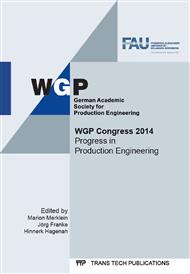[1]
IFR Statistical Department, World robotics 2013: Industrial robots, (2013).
Google Scholar
[2]
ISO-9283, Manipulating Industrial Robots – Performance Criteria and Related Test Methods, Beuth, Berlin, (1999).
Google Scholar
[3]
VDI-2861, Kenngrößen für Industrieroboter, VDI-Verlag, Düsseldorf, (1988).
Google Scholar
[4]
P.S. Shiakolas, K.L. Conrad, T.C. Yih, On the accuracy, repeatability, and degree of influence of kinematics parameters for industrial robots, International journal of modelling and simulation 22 (2002), 245–254.
DOI: 10.1080/02286203.2002.11442246
Google Scholar
[5]
U. Gerstmann, Robotergenauigkeit: Der Getriebeeinfluss auf die Arbeits- und Positionsgenauigkeit, Dissertation, VDI-Verlag, Düsseldorf, (1991).
Google Scholar
[6]
A.C. Bittencourt, E. Wernholt, S. Sander-Tavallaey, T. Brogårdh, An extended friction model to capture load and temperature effects in robot joints, in: 2010 IEEE/RSJ International Conference on Intelligent Robots and Systems (IROS 2010), 2010, p.6161.
DOI: 10.1109/iros.2010.5650358
Google Scholar
[7]
G. Reinhart, R. -G. Gräser, R. Klingel, Qualification of Standard Industrial Robots to Cope with Sophisticated Assembly Tasks, CIRP Annals - Manufacturing Technology 47 (1998) 1–4.
DOI: 10.1016/s0007-8506(07)62772-3
Google Scholar
[8]
U. Wiest, Kinematische Kalibrierung von Industrierobotern, Dissertation, Shaker Verlag, Aachen, (2001).
Google Scholar
[9]
T. Bongardt, Methode zur Kompensation betriebsabhängiger Einflüsse auf die Absolutgenauigkeit von Industrierobotern, Dissertation, Utz Verlag, München, (2004).
Google Scholar
[10]
A.C. Bittencourt, P. Axelsson, Modeling and Experiment Design for Identification of Wear in a Robot Joint Under Load and Temperature Uncertainties Based on Friction Data, IEEE/ASME Transactions on Mechatronics 19 (2014) 1694–1706.
DOI: 10.1109/tmech.2013.2293001
Google Scholar
[11]
M. Ruderman, F. Hoffmann, T. Bertram, Modeling and Identification of Elastic Robot Joints With Hysteresis and Backlash, IEEE Trans. Ind. Electron. 56 (2009) 3840–3847.
DOI: 10.1109/tie.2009.2015752
Google Scholar
[12]
H. Chen, T. Fuhlbrigge, S. Choi, J. Wang, X. Li, Practical industrial robot zero offset calibration, in: 2008 IEEE International Conference on Automation Science and Engineering (CASE 2008), 2008, p.516–521.
DOI: 10.1109/coase.2008.4626417
Google Scholar


